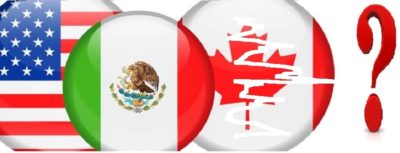By Bob Brewer, VP BLG Marketing
President Trump recently lashed out with a new automobile related tariff threat against Canada, who at this time is sitting on the sidelines of the negotiation process, while retaliating against the steel and aluminum tariffs the U.S. slapped on them a few months ago. In the meantime, ongoing NAFTA negotiations are simply one-on-one talks between the United States and Mexico, and have been for the last few weeks. Government officials close to the process feel like the negotiations between the U.S. and Mexico have been building momentum in recent weeks, and expect the bilateral talks to continue for the next couple of weeks.
In a recent tweet regarding NAFTA’s renegotiation, President Trump said the “deal with Mexico is coming along nicely” and that “Canada must wait.” He then said, in reference to Canada, “Their Tariffs and Trade Barriers are far too high. Will tax cars if we can’t make a deal!”
President Trump has made it clear that he will not hesitate to inflict Canada with even more damaging tariffs, but of course, the real gasoline on the U.S.-Canada fire was when, not too long ago, he called Prime Minister Justin Trudeau very dishonest and weak” shortly after leaving the G7 meeting in Quebec. At the same time that Trudeau has fallen from favor with the POTUS, he has been praising Mexico’s president-elect Andres Manuel Lopez Obrador, stating that “New President of Mexico has been an absolute gentleman.” Obrador doesn’t actually take office until December 1st, but he would very much like to separate himself from the past administration with a victory for Mexico in the renegotiation.
Various media reports said recent NAFTA discussions between U.S. Trade Representative Robert Lighthizer and Mexican Economy Minister Ildefonso Guajardo concluded with an agreement that there was a lot more bilateral work to be done. Guajardo indicated the two sides have made progress and that they will meet again next week to continue their talks for a fourth straight week.
In regard to their sideline position, Canada states that there have been several unilateral discussions over the past few months in the negotiations, and that they are simply waiting for the U.S. and Mexico to resolve their issues before they rejoin the talks. There is of course the obvious, and that is that Canada is not going to simply accept what the U.S. and Mexico agree to, as they have their own agenda. There are several sticking points that include dispute resolution, agriculture issues, intellectual property, government procurement, the proposed inclusion of a five-year sunset clause and the de minimis threshold, which is the maximum value of an item that Canadians can order from a foreign country without paying duties or taxes.
Adam Austen, a spokesman for Canadian Foreign Minister Chrystia Freeland, who is leading NAFTA trade talks for Canada, said the minister was in regular contact with her Mexican and U.S. counterparts. The key issues the U.S. and Mexico are working on include what percentage of auto industry components need to be made in North America to avoid tariffs, and how many cars and trucks need to be made in factories paying higher wages.
If you recall, and of course, you probably don’t, I did a little research on the subject in an article I wrote about (3) months ago. Let me restate a paragraph from that article for consideration. A major change sought by the White House is the manner in which NAFTA calculates the regional content of where a new car or truck is manufactured. That affects whether a vehicle is considered “made in America” or labeled an import. This is no small consideration since Mexico is the largest provider of auto parts to the United States, and the United States is the largest provider of auto parts to Mexico. Mexico exports roughly $46 billion in auto parts to the U.S., while the U.S. exports an estimated $20 billion in auto parts annually to Mexico. So, vehicle co-production ladies and gentlemen, which cannot easily be “undone” is roughly $3800 in Mexican parts per car go into each vehicle made in the U.S., and an estimated $5,500 in U.S. parts per car go into each vehicle manufactured in Mexico. So, they are actually all “Made in North America.” If the Trump administration got its way the effect would be to pressure auto makers to shift a lot more production to the U.S. from Canada and Mexico, an outcome neither of those two countries is willing to accept.
As I stated, I wrote the above paragraph about (3) months ago, and not much has changed in the negotiations since. Some are optimistic, and think that a deal could be reached by the end of August 2018, while others are realistic, and feel that this bilateral, then maybe trilateral, then bilateral, possibly unilateral negotiation will end sometime mid 2019. The POTUS at the time of this writing is committed to keeping the NAFTA together, but that of course remains to be seen.

























